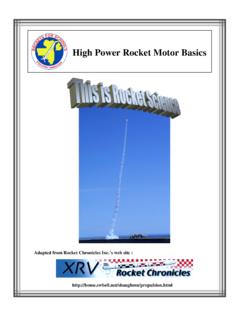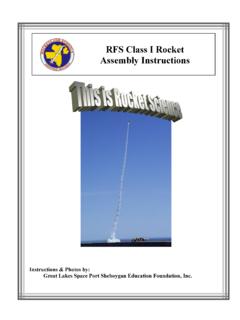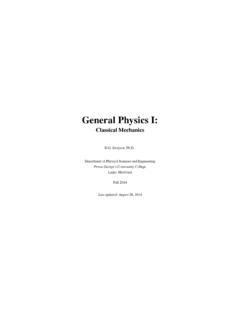Transcription of Rocketry Basics - Rockets for Schools
1 Rocketry Basics This pamphlet was developed using information from the Education Working Group NASA Johnson Space Center This publication was developed for theNational Aeronautics and SpaceAdministration with the assistance ofhundreds of teachers in the Texas Region IVarea and educators of the AerospaceEducation Services Program, OklahomaState :Deborah A. ShearerGregory L. Vogt, From Space ProgramNASA Johnson Space CenterHouston, TXEditor:Carla B. RosenbergTeaching From Space ProgramNASA HeadquartersWashington, DCSpecial Thanks to:Timothy J. WickenheiserChief, Advanced Mission Analysis BranchNASA Lewis Research CenterGordon W. EskridgeAerospace Education SpecialistOklahoma State UniversityDale M. OliveTeacher, HawaiiAcknowledgmentsi4 Rockets : A Teacher's Guide with Activities in Science, mathematics , and TechnologyEG-1999-06-108-HQ5 RRockets: A Teacher's Guide with Activities in Science, mathematics , and TechnologyEG-1999-06-108-HQBrief History ofRocketsscience and technology of the past.
2 They arenatural outgrowths of literally thousands of years ofexperimentation and research on Rockets and of the first devices to successfullyemploy the principles essential to rocket flight was awooden bird. The writings of Aulus Gellius, aRoman, tell a story of a Greek named Archytas wholived in the city of Tarentum, now a part of southernItaly. Somewhere around the year 400 ,Archytas mystified and amused the citizens ofTarentum by flying a pigeon made of steam propelled the bird suspended onwires. The pigeon used the action-reactionprinciple, which was not to be stated as a scientificlaw until the 17th three hundred years after the pigeon,another Greek, Hero of Alexandria, invented asimilar rocket -like device called an aeolipile. It,too, used steam as a propulsive gas. Heromounted a sphere on top of a water fire below the kettle turned the water intosteam, and the gas traveled through pipesto the sphere.
3 Two L-shaped tubes onopposite sides of the sphere allowed the gasto escape, and in doing so gave a thrust to thesphere that caused it to when the first true Rockets appeared isunclear. Stories of early rocket -like devices appearsporadically through the historical records of variouscultures. Perhaps the first true Rockets wereaccidents. In the first century , theChinese reportedly had a simple form ofgunpowder made from saltpeter, sulfur, andcharcoal dust. They used the gunpowdermostly for fireworks in religious and otherfestive celebrations. To create explosionsduring religious festivals, they filled bamboo tubeswith the mixture and tossed them into some of those tubes failed to explode andinstead skittered out of the fires, propelled by thegases and sparks produced from the Chinese began experimenting with thegunpowder-filled tubes.
4 At some point, theyattached bamboo tubes to arrows and launchedthem with bows. Soon they discovered thatthese gunpowder tubes could launchthemselves just by the power producedfrom the escaping gas. The true rocket Engineoday s Rockets are remarkable collections ofhuman ingenuity that have their roots in theT6 Rockets : A Teacher's Guide with Activities in Science, mathematics , and TechnologyEG-1999-06-108-HQThe date reporting the first use of truerockets was in 1232. At this time, the Chinese andthe Mongols were at war with each other. Duringthe battle of Kai-Keng, the Chinese repelled theMongol invaders by a barrage of arrows of flyingfire. These fire-arrows were a simple form of asolid-propellant rocket . A tube, capped at one end,contained gunpowder. The other end was left openand the tube was attached to a long stick.
5 Whenthe powder ignited, the rapid burning of the powderproduced fire, smoke, and gas that escaped out theopen end and produced a thrust. The stick acted asBy the 16th century Rockets fell into a time ofdisuse as weapons of war, though they were stillused for fireworks displays, and a German fireworksmaker, Johann Schmidlap, invented the steprocket, a multi-staged vehicle for lifting fireworks tohigher altitudes. A large sky rocket (first stage)carried a smaller sky rocket (second stage). Whenthe large rocket burned out, the smaller onecontinued to a higher altitude before showering thesky with glowing cinders. Schmidlap s idea is basicto all Rockets today that go into outer all uses of Rockets up to this timewere for warfare or fireworks, but an interesting oldChinese legend reports the use of Rockets as ameans of transportation.
6 With the help of manya simple guidance system that kept the rocketheaded in one general direction as it flew throughthe air. How effective these arrows of flying firewere as weapons of destruction is not clear, buttheir psychological effects on the Mongols musthave been the battle of Kai-Keng, theMongols produced Rockets of their own and mayhave been responsible for the spread of Rockets toEurope. Many records describe rocket experimentsthrough out the 13th to the 15th centuries. InEngland, a monk named Roger Bacon worked onimproved forms of gunpowder that greatly increasedthe range of Rockets . In France, Jean Froissartachieved more accurate flights by launching rocketsthrough tubes. Froissart s idea was the forerunnerof the modern bazooka. Joanes de Fontana of Italydesigned a surface-running rocket -powered torpedofor setting enemy ships on , a lesser-known Chinese official namedWan-Hu assembled a rocket -powered flying had two large kites attached to the chair, andfixed to the kites were forty-seven the day of the flight, Wan-Hu sat himselfon the chair and gave the command to light therockets.
7 Forty-seven rocket assistants, each armedwith torches, rushed forward to light the fuses. Atremendous roar filled the air, accompanied bybillowing clouds of smoke. When the smokecleared, Wan-Hu and his flying chair were gone. Noone knows for sure what happened to Wan-Hu, butif the event really did take place, Wan-Hu and hischair probably did not survive the explosion. Fire-arrows were as apt to explode as to Becomes a ScienceDuring the latter part of the 17th century, thegreat English scientist Sir Isaac Newton (1642-1727) laid the scientific foundations for modernrocketry. Newton organized his understanding ofphysical motion into three scientific laws. The lawsexplain how Rockets work and why they are able towork in the vacuum of outer space. (See RocketPrinciples for more information on Newton s ThreeLaws of Motion beginning on page 13.)
8 Surface-Running TorpedoChinese soldier launches a Fire-Arrows7 RRockets: A Teacher's Guide with Activities in Science, mathematics , and TechnologyEG-1999-06-108-HQTsiolkovsky rocket DesignsAustrian rocket brigades met their match againstnewly designed artillery pieces. Breech-loadingcannon with rifled barrels and exploding warheadswere far more effective weapons of war than thebest Rockets . Once again, the military relegatedrocketry to peacetime Rocketry BeginsIn 1898, a Russian schoolteacher,Konstantin Tsiolkovsky (1857-1935), proposed theidea of space exploration by rocket . In a report hepublished in 1903, Tsiolkovsky suggested the use ofliquid propellants for Rockets in order to achievegreater range. Tsiolkovsky stated that only theexhaust velocity of escaping gases limited thespeed and range of a rocket .
9 For his ideas, carefulresearch, and great vision, Tsiolkovsky has beencalled the father of modern in the 20th century, an American,Robert H. Goddard (1882-1945), conductedpractical experiments in Rocketry . He had becomeinterested in a way of achieving higher altitudesthan were possible for lighter-than-air balloons. Hepublished a pamphlet in 1919 entitled A Method ofReaching Extreme Altitudes. Today we call thismathematical analysis the meteorological his pamphlet, Goddard reached severalconclusions important to Rocketry . From his tests,he stated that a rocket operates with greaterNewton s laws soon began to have apractical impact on the design of Rockets . About1720, a Dutch professor, Willem Gravesande, builtmodel cars propelled by jets of steam. Rocketexperimenters in Germany and Russia beganworking with Rockets with a mass of more than 45kilograms.
10 Some of these Rockets were so powerfulthat their escaping exhaust flames bored deepholes in the ground even before the end of the 18th century and earlyinto the 19th, Rockets experienced a brief revival asa weapon of war. The success of Indian rocketbarrages against the British in 1792 and again in1799 caught the interest of an artillery expert,Colonel William Congreve. Congreve set out todesign Rockets for use by the British Congreve Rockets were highlysuccessful in battle. Used by British ships to poundFort McHenry in the War of 1812, they inspiredFrancis Scott Key to write the Rockets red glare, inhis poem that later became The with Congreve s work, the accuracy ofrockets still had not improved much from the earlydays. The devastating nature of war Rockets wasnot their accuracy or power, but their a typical siege, thousands of them might befired at the enemy.








